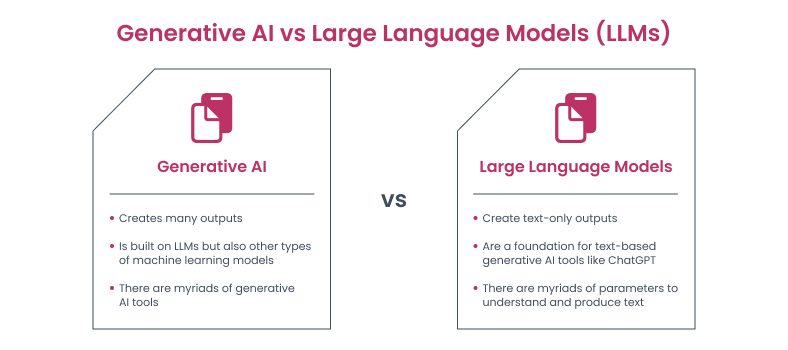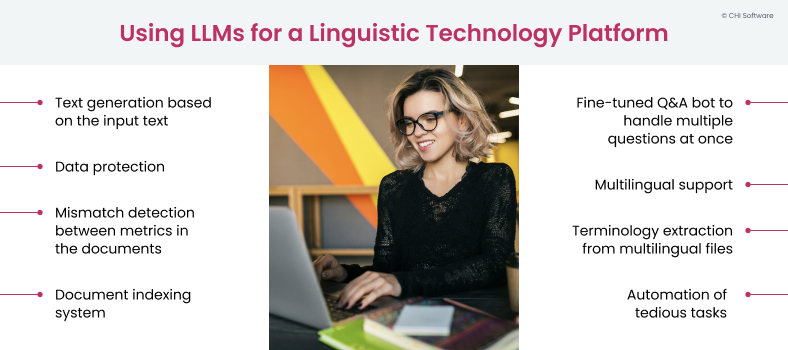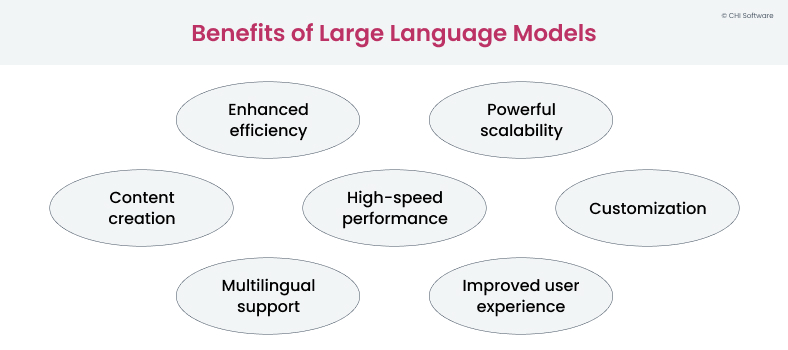Benefits of LLMs (Large Language Models) are making waves in the world of artificial intelligence, and for good reason. But what exactly makes these models so powerful?
The fact is that LLMs go beyond traditional linguistic solutions and can understand and generate human-like text. As a result, they offer unprecedented opportunities to streamline operations and improve the customer experience.
So, let’s look at the benefits of large language models and how they can help you achieve your goals.
What Is the Difference Between Large Language Models and Generative AI?
There is a phrase you might encounter: every LLM is a generative AI, but not every generative AI is an LLM. Sounds pretty convoluted, right? Let’s try to decipher what that actually means.

LLMs specialize in the generation and understanding of human language. With recent advancements, the scope of what LLMs can do has gotten bigger, and now they can be multimodal. This means that instead of generating solely text, they can also generate images, videos, sounds, etc. All of this makes LLMs a subset of generative AI.
Check out our comprehensive list of AI technologies for your linguistic solution
Continue reading
Generative AI, on the other hand, is a term applied to a broad spectrum of models focused on content creation. AI doesn’t need LLMs to be considered generative since there are Generative Adversarial Networks (GANs) and Recurrent Neural Networks (RNNs) that can generate images and music, respectively.
At CHI Software, we offer generative AI consulting services to help businesses harness the power of these advanced models for innovative content creation and operational efficiencies. Now that we’ve covered the difference, let’s focus on how large language models transform businesses.
How Does It Work in Practice? Using LLMs for the Linguistic Technology Platform
With AI becoming more accessible to more businesses and regular users, we can divide the timeline of pretty much every industry into a “pre-AI” and “post-AI” phase.
The same applies to our client’s linguistics business. They reached out to CHI Software with a couple of goals in mind:
- Automate and optimize a question-answering system;
- Create a smart scraping solution for more efficient data extraction;
- Enhance data security and create an opportunity for scalability.
We provided the business with an AI-powered linguistics tool that utilizes large language models for competitive advantage, efficiency, and security. But what did we do exactly?

First off, we did a lot of research. Based on that, we decided that it’s better to divide this tool into three solutions:
- The Q&A chatbot simplifies responses to internal and external queries. Additionally, it comes with a built-in document indexer;
- Web-scraper extracts information from websites, taking into account the hierarchical structure of web pages;
- Migration to provide better security. One of our client’s concerns was security and dependency on third parties. To address this issue, we conducted the migration to Meta’s LLaMa-2. It strengthened data security, minimized risks associated with external services, and allowed for the creation of custom APIs.
The tool’s features include:
- Text generation based on the input text;
- Terminology extraction from multilingual files;
- Mismatch detection between metrics in the documents;
- Document indexing system;
- Fine-tuned Q&A bot to handle multiple questions at once;
- Data protection;
- Multilingual support;
- Automation of tedious tasks.
Even though the project is still ongoing, our client has already seen the first results of our collaboration:
- +20% efficiency boost after the Q&A system adoption;
- +15% improvement of data extraction;
- +40% increase in data security and architectural independence.
To learn more about the advantages of large language models, check out our case study. And now, let’s check what to expect from large language models for business innovation.
7 Benefits of Large Language Models for Business
Let’s focus more of our attention on the usefulness of a large language model in business.

Efficiency improvement: Large language models in business automate tasks that involve data analysis, effectively reducing the need for manual intervention. They also complete those tasks much faster than humans. With analysis and automation combined, you can expect an increase in business efficiency with large language models.
Powerful scalability: You might think that LLMs don’t need to be scaled even further. They already have “large” in their name, don’t they? But you’d be surprised to see the sheer amount of data that some projects will require. Thankfully, LLMs can scale to handle pretty much any data volume. LLM implementation in business operations is a must for scaling.
Learn the fundamentals of chatbot security with our guide
Read more
High-speed performance: At this point, we are far past the time when everything requires you to wait for hours or even days. LLMs for business applications are generally known for their speed and low-latency responses, and thus, they are widely used in chatbots.
Customization: As we already said, recent advancements have made LLMs multimodal. Thanks to their high customization, LLMs can be tailored to fit any of your needs – it only takes a bit of training and fine-tuning.
Multilingual support: Imagine if a large language model couldn’t work with multiple languages. That would raise a lot of questions. Fortunately, this is not the case, and we live in a world where LLMs provide global communication and information access.
Improved user experience: Since advantages of LLMs are used in almost every chatbot, search engine, and virtual assistant, you might have already encountered some of the solutions containing LLMs. The main reasons they are used everywhere are context-aware responses and sentiment analysis, which provide more meaningful interactions.
AI at Your Service: How Chatbots Are Shaping the Future of Workplace Productivity
Read more
Content creation: For some people, content creation might be hard due to a lack of inspiration or practical skill. This is especially true when it comes to tedious tasks like creating item descriptions or writing formal letters. That’s where LLMs come in! They can generate content for websites, blogs, social media, etc.
However, to unlock the full potential of large language models for business, it is recommended that humans and AI work together. This way, your content will stay in line with your tone of voice.
Summarizing all of the benefits, we can conclude that large language models are fast, flexible, and, most importantly, can save you a lot of money on maintenance.
Conclusion
If AI invention can be compared to the discovery of fire, then LLM creation is like the invention of smelting. The potential behind this technology is enormous, and the examples that we can see today are only confirming it.
After we discussed leveraging LLMs for success based on our experience and the benefits LLMs bring, you might be interested in utilizing this technology in your business operations. But to do that, you need a team of experts in this field.
Luckily, you found us! As a leading Generative AI development company, we will happily help you out with your projects. Contact us, and we will provide you with the best services you’ve ever had!
FAQs
-
What are large language models?

A Large Language Model (LLM) is a type of AI trained to understand and generate human text. With recent advancements, LLM expanded what it can do, resulting in the generation of almost any type of media.
Business applications for large language models include tasks that involve text. Think translation, summarization, answering questions, content creation, etc.
-
What benefits can businesses derive from large language models?

The benefits of large language models for business bring a lot of attention to this tech. And no wonder! The main benefits of LLM are:
- automation of tedious tasks, such as data analysis;
- easy scaling to handle any amount of data;
- speedy performance and low latency;
- practically limitless customization ability;
- the ability work with multiple languages;
- understanding of the context and sentiment of the text;
- the ability to generate new content based on your needs.
-
How do large language models improve communication and efficiency in business operations?

LLM are especially good at understanding and generating human text. To do that, then analyze large amounts of text data. So, any process that requires data analysis can be automated by LLM. Additionally, you can enhance business processes with LLMs by delegating interactions with customers in the form of chatbots.
-
What are the key differences between traditional language processing and large language models in a business context?

When people talk about traditional language models, they refer to rule-based language models. Since you can’t write a rule for every interaction ever, they are not flexible and can’t quite scale properly.
LLMs don’t require hard-coded rules. The learning process is done solely by machine learning algorithms. This makes them very flexible and gives them the ability to scale without any errors.
-
How can businesses measure the ROI of incorporating large language models?

If you decide to use LLM (Large Language Model) in business, at some point, you will be interested in calculating the return on investments. But how do you do that? Let’s cover the rough outline of what you need to do:
1. You need to define benchmarks for tasks. For example, response time, the volume of content creation, etc. Then, you need to track the cost of operations based on the benchmarks.
2. Another important metrics you need to track are customer satisfaction and engagement. To do this, use surveys and analytics tools.
3. After you have all of the metrics and benchmarks, it’s time to research how much revenue has increased from the moment you adopted LLM.
4. All that’s left to do is to compare efficiency before and after LLM adoption.
About the author
Alex is a Data Scientist & ML Engineer with an NLP specialization. He is passionate about AI-related technologies, fond of science, and participated in many international scientific conferences.
Rate this article
22 ratings, average: 4.5 out of 5





